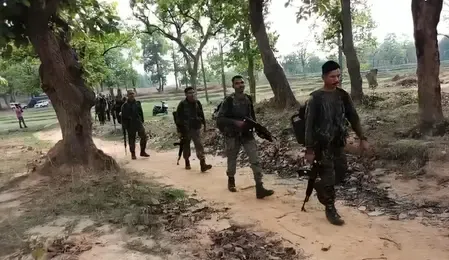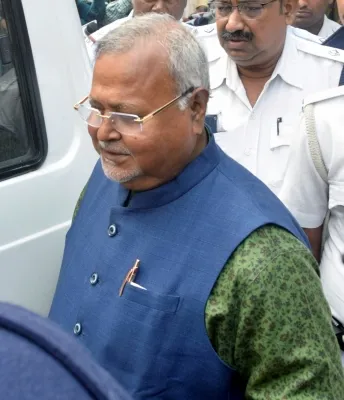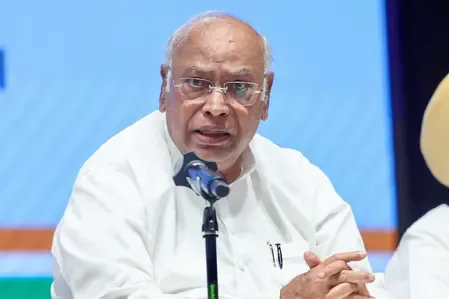Have Several Maoists Been 'Neutralised' in the Bijapur-Gadhchiroli Gun Battle?

Synopsis
Key Takeaways
- Ongoing operations indicate a significant crackdown on Maoist insurgency.
- The operation is a collaborative effort involving various security agencies.
- Improved intelligence-sharing has played a crucial role in these operations.
- Rehabilitation policies are contributing to the surrender of Maoist cadres.
- The terrain poses challenges for security forces but is being managed effectively.
Raipur/Gadhchiroli, Nov 11 (NationPress) A fierce gunfight has been ongoing since Tuesday morning along the Chhattisgarh-Maharashtra border, specifically in the dense forests surrounding the Bijapur and Gadhchiroli districts. Preliminary reports from security forces indicate that several Maoists have been neutralised.
The operation, which includes joint teams from District Reserve Guards (DRG), CoBRA commandos, and local police, has drawn Maoist insurgents into a prolonged firefight, representing a significant setback for the insurgency in Bastar.
While official confirmation regarding the precise number of casualties is pending, the exchange of fire continues intermittently, with security forces maintaining a cordon to prevent any escapes.
According to officers from the Chhattisgarh Police, who requested anonymity, multiple hardcore Maoists are believed to have been killed, but the final count will only be known once the search operation concludes and the area is fully sanitised.
So far, no injuries among security forces have been reported. However, reinforcements from nearby camps have been deployed to support the assault.
The clash began around 6 a.m. when a joint patrol, acting on specific intelligence about 20-25 armed ultras from the banned CPI (Maoist)'s Dandakaranya Special Zonal Committee, encountered the insurgents in a forested area.
The Maoists, allegedly led by senior commanders, opened fire with automatic weapons and grenades, prompting a strong retaliation.
The challenging terrain, characterized by thick undergrowth and ravines, has favored the rebels' hit-and-run tactics, extending the encounter into its third day.
This operation is taking place amidst a rise in anti-Naxal activities in the region.
Just two days prior, on November 9, a brief skirmish occurred in the nearby Sukma forests, where security forces confronted a splinter Maoist group.
The insurgents managed to escape into the undergrowth, but DRG teams have since intensified their combing operations, recovering abandoned explosives and propaganda materials.
Reports suggest that the fleeing group may have linked up with the larger cadre involved in the ongoing Bijapur-Gadhchiroli clash.
The encounter on November 5-6 along the Bijapur-Telangana border, which resulted in the deaths of three Maoists, including a deputy commander with a ₹5 lakh bounty, set the stage for this escalation. That operation, carried out by Telangana Greyhounds and Chhattisgarh STF, also yielded two AK-47 rifles and IED components, highlighting the Maoists' desperation to regroup amid unrelenting pressure.
The Bastar division of Chhattisgarh, known as a Maoist stronghold, has seen a significant reduction in insurgent activity this year.
Since January, over 400 cadres have surrendered, citing improved rehabilitation policies from the state government's 2025 Surrender and Rehabilitation Scheme, which offers skill training, housing, and stipends up to ₹2.5 lakh.
High-profile neutralisations, such as the February Bijapur clash that resulted in the deaths of 31 Maoists, have weakened the group's command structure, shrinking their operational reach to just 12 districts nationwide.
Recently, State Home Minister Vijay Sharma, during his visit to Bijapur, called for surrenders and lauded the ongoing operations as a decisive step toward a Naxal-free Bastar.
He reiterated the government's dual approach of kinetic operations and development initiatives, including enhancing road connectivity and mobile health units in remote areas.
Security analysts attribute the Maoists' vulnerability to improved intelligence-sharing among states, supported by drone surveillance and human informants.
The strategic importance of the border area, which serves as a transit route for arms smuggling from Maharashtra, underscores the necessity of such joint operations.
As the search intensifies, authorities expect to recover weapon caches, including INSAS rifles and gelatin sticks, which are typical of Maoist arsenals.








